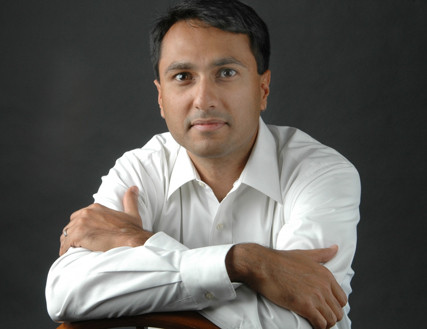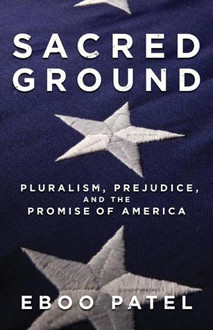 Eboo Patel (@eboopatel) is the author of Sacred Ground: Pluralism, Prejudice, and the Promise of America and Acts of Faith, and the founder of the Interfaith Youth Core. (Photo courtesy of IFYC)
Eboo Patel (@eboopatel) is the author of Sacred Ground: Pluralism, Prejudice, and the Promise of America and Acts of Faith, and the founder of the Interfaith Youth Core. (Photo courtesy of IFYC)
It’s easy to feel helpless when reading about the recent shooting at a Sikh gurdwara on the south side of Milwaukee, Wisconsin. What could possibly counter the kind of weaponized prejudice that resulted in the death of seven and traumatic injuries—both literal and emotional—to so many more?
Eboo Patel, one of the country’s most dynamic interfaith leaders, has an idea. Get kids from different religious backgrounds together while they’re young. Don’t talk at them. Get them working side by side, serving others. Their friendships will change the world.
The Interfaith Youth Core (IFYC), the organization he founded, has been doing just this to great effect for over a decade. Its mission is “to make religious pluralism a social norm within the course of a generation.”
Lest its method sound simple, think again; Patel and his team base their chosen intervention on rigorous academic research from the likes of Harvard sociologist Robert Putnam, as well as McKinsey-backed corporate research on how they can actually have impact, not just light candles and talk about “tolerance.”
Are you enjoying this article? Read more like this, plus SSIR's full archive of content, when you subscribe.
In his new book, Sacred Ground: Pluralism, Prejudice, and the Promise of America, Patel lays out a strong argument for the vitality and necessity of interfaith service work in our post-9/11 world. He took time out of his book tour to talk to me about how this growing interfaith movement can counter growing hatred.

Courtney Martin: In light of the tragic shooting in Milwaukee recently, your book couldn't be more timely. How do you distinguish between the kind of religious prejudice that clearly exists in the United States in an everyday way and moments like these where prejudice is blown up to violent proportions by mental illness? Are they on a spectrum? Is it disingenuous to speak of them in the same breath?
Eboo Patel: People like Wade Michael Page (the murderer of Sikhs in Wisconsin) and Anders Brevik (who murdered over 75 people in Norway last summer in the name of opposing Muslims and multiculturalism) might act alone, but they are nurtured by movements and grow emboldened in cultures of hate. In the case of Page, it was the white supremacist music scene. In the case of Brevik, it was the rhetoric of the industry of Islamphobia—a story that I actually tell at the end of Sacred Ground. The great Rabbi Abraham Joshua Heschel wrote, “Speech has power. Words do not fade. What starts out as a sound, ends in a deed.”
That’s why the kind of ugly speech we hear about Muslims, Mormons, gays, atheists—you name it—is so dangerous. It undoubtedly threatens the groups in question and weakens the bonds of a diverse society.
In Sacred Ground, you trace the ways in which Evangelical attacks against Muslims today are eerily similar to Evangelical attacks against Catholics leading up to JFK's election and write, "When Evangelicals change, America changes." What makes you hopeful about the possibility of that shift?
When it comes to Evangelicals and Muslims, the loudest narrative is the one about prejudice. But Evangelicals are a large and diverse community. They do an awful lot of good in this country and around the world—their message is the center of meaning in many people’s lives and their institutions of service feed, clothe, heal, and house literally tens of millions of people around the world. They should not be written off because some of their more visible representatives say ugly things.
Susan Sontag has a great insight: Whatever is happening, something else is always going on. What else is going on when it comes to Evangelicals and interfaith relations is the emergence of people like Bob Roberts, a Southern Baptist deep in the heart of Texas, who has organized large-scale interfaith programs at his church and preaches to young pastors across the country about the importance of being interfaith leaders.
Just as Evangelicals changed their attitudes towards Catholics, AIDS, race relations, and many other communities and people, I think Evangelicals are on the cusp of important change when it comes to their relations with Muslims. I’d rather find the hopeful figures within any community and support their work, even if it’s a bit out of the limelight, than simply denounce the ugliness of some of the folks everyone has already heard of.
You write, "If your organization is growing but the problem your organization claims to solve is growing faster, then maybe something you're doing is wrong." I'm sure those brutally honest words will hit a lot of organizational directors like a punch in the gut. At first, you had an aversion to thinking of your interfaith work in the scientific terms of impact, but eventually you warmed up to it. What would you suggest to other leaders who say that their work evades measurement of this kind?
Nonprofit presidents—and I am one of these people—love citing the stats about how much worse their problem is getting, whether it’s poverty or housing or disease. But unless your organization is pure advocacy and its purpose is simply to ring the alarm bell and propose plans for other people to implement, this is an ironic strategy.
The world has lot of problems, and we hear about these problems all the time. In fact, most people tune problems out. What the world is lacking is compelling solutions and leaders and organizations implementing those in inspiring ways.
I learned this lesson the hard way. Boy was I good at citing how much worse religious prejudice was getting for a long time. That was until I went on a Sunday morning talk show and was asked by the host if I thought my work had accomplished anything in front of 2 million viewers. The insight that came out of that was the recognition that with an organization titled Interfaith Youth Core, people looked to me not to ring the alarm bell on the problem of religious prejudice, but to implement and scale solutions for it.
The nice thing about the research on religious prejudice is that it shows us how to solve the problem—through relationships between people of different faiths and appreciative knowledge about other traditions. Effective interfaith programs work that attitudes-knowledge-relationships interfaith triangle. Now, when you hear me speak, you hear about solutions not problems, and how you can be part of the story of solving the problem, rather than simply learning more about how ugly the problem is.
One of the obstructions to impact that you identify for your own organization is your own attraction to wide-ranging conversations, unusual speaking engagements, challenging press opportunities, etc. You write, "If interfaith cooperation could be morphed into anything, then it was really about nothing. If interfaith cooperation went easily everywhere, then its impact was really nowhere." What would you say to other leaders of organizations and movements who say that this is the important work of raising the profile of the organization or movement, not a distraction?
I learned that being a wide-ranging public intellectual and building Interfaith Youth Core into an effective and focused institution were two different things. I had to choose a path. Do I talk about the things that strike my fancy on the lecture circuit, or do I try to advance a science of interfaith cooperation and grow a critical mass of interfaith leaders who apply it effectively, one day making interfaith cooperation a social norm? I chose the latter.
There are lots of reasons for it. One is that I think the opportunity to build an institution that advances a real solution to a terrible problem is a God-given, once-in-a-lifetime opportunity, and I don’t want to pass it up. The people that I admire most in the world are the ones who focused on solving a problem and had the discipline to build strong, focused institutions as vehicles to do so. Bill Drayton at Ashoka, Wendy Kopp at TFA, Geoffrey Canada at Harlem Children’s Zone—these are just a few examples.
I think Jane Addams at Hull House was our civic leader foremother. There are lots of people who can sound off intelligently on contemporary issues, much better than me actually. That’s fun, but it’s a little like Chinese food—it doesn’t fill me up in the long term. Plus there’s a little bit of “look at how smart I am” in that. Whatever part of me wants to show that, I’m not interested in growing. I’d rather say, “I was part of the team that advanced religious pluralism and reduced religious prejudice in the long term.”
When you did come around to thinking in a more focused and disciplined way about IFYC's impact, you decided to focus your efforts on college campuses and seminaries. One might argue that the most at-risk populations, in terms of religious ignorance and segregation, would be the 30 percent of Americans who don't ever enroll in college. What happens to them?
The alumni from our college campus program launch programs and organizations work with all kinds of populations that we don’t deal with directly at IFYC; more at-risk populations are one example. Take Frankie Fredericks, who was an IFYC Fellow a few years back (I tell a bit of his story in Sacred Ground), and has since launched an organization called World Faith, which has active chapters in countries that have strong extremist movements and where religious volatility frequently results in violence.
One of the metaphors I use in this book is “preaching to the choir”—except I use it positively. I say this is exactly what we do at IFYC. We are the preacher teaching the lyrics and notes of the song of interfaith cooperation to a choir of college students, staff, and faculty who are eager to hear it. Our job is, first of all, to get them to sing. That way, the cacophony of religious prejudice gets drowned out by the beauty of the song of interfaith cooperation.
Another way to put that is the narrative of religious pluralism gets so strong and normalized that the kind of ugliness we saw around the opposition to the “Ground Zero Mosque,” the anti-Sharia movement in America, and the prejudice against Mormons and atheists are seen as so marginal and anti-American that they never get any traction.
In addition to getting the choir to sing, the preacher has a second important task: to teach the most talented choir members to be preachers themselves, and go off and cultivate their own choirs. That’s precisely the IFYC approach. Our staff and programs are best suited to reach the sector of college campuses. But just like Teach For America alum and Ashoka Fellows launch projects that impact all kinds of populations and sectors, so do our alum, and it’s precisely because we teach them not just how to sing the song of religious pluralism, but also the skills to be a preacher, or an interfaith leader, and start their own choir.
If you could ask MLK and/or Gandhi one question about interfaith collaboration, what would it be?
How did you remain so committed to the fullness and distinctiveness of truth in your own tradition while having such deep respect for the traditions of others?
Support SSIR’s coverage of cross-sector solutions to global challenges.
Help us further the reach of innovative ideas. Donate today.
Read more stories by Courtney E. Martin.

